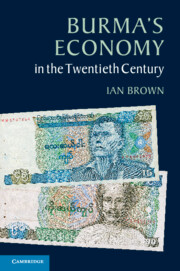Book contents
- Frontmatter
- Dedication
- Contents
- List of Illustrations
- List of Tables
- Note on names
- Acknowledgements
- Map of Burma/Myanmar
- Introduction
- 1 The economy at the beginning of the twentieth century
- 2 Strains in the late colonial economy
- 3 War and independence
- 4 In pursuit of socialism
- 5 Toward the market: the economy from 1988
- Conclusion: themes and threads
- Bibliography
- Index
- References
2 - Strains in the late colonial economy
Published online by Cambridge University Press: 05 June 2014
- Frontmatter
- Dedication
- Contents
- List of Illustrations
- List of Tables
- Note on names
- Acknowledgements
- Map of Burma/Myanmar
- Introduction
- 1 The economy at the beginning of the twentieth century
- 2 Strains in the late colonial economy
- 3 War and independence
- 4 In pursuit of socialism
- 5 Toward the market: the economy from 1988
- Conclusion: themes and threads
- Bibliography
- Index
- References
Summary
The closing rice frontier
The extraordinary increase in rice production and exports in the final decades of the nineteenth century, and the consequent establishment of Burma as the single most important rice exporting country in the world, was achieved through a huge expansion in the area under cultivation. Cultivation methods and inputs remained essentially unchanged but were now being employed on a vastly greater scale. This expansion was possible, of course, because when the British annexed lower Burma in the early 1850s, the great deltaic plain of the Irrawaddy and Sittang rivers was sparsely populated and largely abandoned to nature. There was a vast open frontier. But inevitably, in time, the frontier would begin to close and the pace of expansion would slacken. That time came in the first decades of the twentieth century.
Table 2.1 records the annual average acreage of paddy land in lower Burma in the first four decades of the twentieth century. It should be read alongside Table 1.1 in the previous chapter, recording paddy acreage in the second half of the nineteenth century. In the final three decades of the nineteenth century, some 3.8 million acres had been added to the area under rice in lower Burma. In the first three decades of the twentieth, the increase was around 2.7 million acres, considerably less although still substantial. It is important to add that this reduced expansion in the rice acreage in the early twentieth century also increasingly involved bringing into cultivation less productive land. As the prime districts came to be cleared and settled – local shortages were being reported from the final years of the nineteenth century – inevitably the pioneer agriculturalist was increasingly forced to turn to tracts with poorer soil, or those prone to excessive flooding.
- Type
- Chapter
- Information
- Burma's Economy in the Twentieth Century , pp. 44 - 79Publisher: Cambridge University PressPrint publication year: 2013



